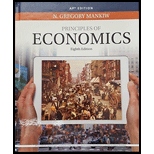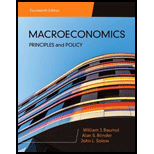
(a):
Meaning of the equation.
(a):
Explanation of Solution
Consumption spending: Consumption spending refers to the amount of expenditure incurred for consuming goods and services at a particular tie period with the given level of income.
Investment: An investment is the money invested in terms of assets and buildings by the individual, for future consumption and profit making.
GDP (Gross domestic product): GDP refers to the market value of all final goods and services produced in an economy during an accounting year.
Multiplier: Multiplier refers to the ratio of change in the real GDP to the change in initial consumption at a constant price rate. A multiplier is positively related to the marginal propensity to consume and negatively related with the marginal propensity to save.
Marginal propensity to consume (MPC): Marginal propensity to consume refers to the sensitivity of change in the consumption level, due to the changes that have occurred in the income level.
(b):
Marginal propensity to consume.
(b):
Explanation of Solution
The slope of the consumption function is the marginal propensity to consume (MPC). Since the consumption function is
Consumption spending: Consumption spending refers to the amount of expenditure incurred for consuming goods and services at a particular tie period with the given level of income.
Investment: An investment is the money invested in terms of assets and buildings by the individual, for future consumption and profit making.
GDP (Gross domestic product): GDP refers to the market value of all final goods and services produced in an economy during an accounting year.
Multiplier: Multiplier refers to the ratio of change in the real GDP to the change in initial consumption at a constant price rate. A multiplier is positively related to the marginal propensity to consume and negatively related with the marginal propensity to save.
Marginal propensity to consume (MPC): Marginal propensity to consume refers to the sensitivity of change in the consumption level, due to the changes that have occurred in the income level.
(c):
Compare with full employmnet level.
(c):
Explanation of Solution
Since the interest rate r is 4 percent, the GDP can be equated as follows:
The GDP is 1800. The calculated GDP
Consumption spending: Consumption spending refers to the amount of expenditure incurred for consuming goods and services at a particular tie period with the given level of income.
Investment: An investment is the money invested in terms of assets and buildings by the individual, for future consumption and profit making.
GDP (Gross domestic product): GDP refers to the market value of all final goods and services produced in an economy during an accounting year.
Multiplier: Multiplier refers to the ratio of change in the real GDP to the change in initial consumption at a constant price rate. A multiplier is positively related to the marginal propensity to consume and negatively related with the marginal propensity to save.
Marginal propensity to consume (MPC): Marginal propensity to consume refers to the sensitivity of change in the consumption level, due to the changes that have occurred in the income level.
(d):
Impact of change in government purchase.
(d):
Explanation of Solution
Assuming no change in
Since the MPC is 0.75, the multiplier can be calculated thus
The multiplier is 4. Thus, to increase GDP by 200
Consumption spending: Consumption spending refers to the amount of expenditure incurred for consuming goods and services at a particular tie period with the given level of income.
Investment: An investment is the money invested in terms of assets and buildings by the individual, for future consumption and profit making.
GDP (Gross domestic product): GDP refers to the market value of all final goods and services produced in an economy during an accounting year.
Multiplier: Multiplier refers to the ratio of change in the real GDP to the change in initial consumption at a constant price rate. A multiplier is positively related to the marginal propensity to consume and negatively related with the marginal propensity to save.
Marginal propensity to consume (MPC): Marginal propensity to consume refers to the sensitivity of change in the consumption level, due to the changes that have occurred in the income level.
(e):
Change in interest rate to bring the economy back to full employment level.
(e):
Explanation of Solution
Assuming no change in fiscal policy, a decrease in interest rate would restore full employment. The amount at which the interest rate needs to be decreased can be calculated as follows:
The interest rate needs to be 3 percent for full employment. Thus, a decrease of 1 percent
Consumption spending: Consumption spending refers to the amount of expenditure incurred for consuming goods and services at a particular tie period with the given level of income.
Investment: An investment is the money invested in terms of assets and buildings by the individual, for future consumption and profit making.
GDP (Gross domestic product): GDP refers to the market value of all final goods and services produced in an economy during an accounting year.
Multiplier: Multiplier refers to the ratio of change in the real GDP to the change in initial consumption at a constant price rate. A multiplier is positively related to the marginal propensity to consume and negatively related with the marginal propensity to save.
Marginal propensity to consume (MPC): Marginal propensity to consume refers to the sensitivity of change in the consumption level, due to the changes that have occurred in the income level.
Want to see more full solutions like this?
Chapter 34 Solutions
Principles Of Economics, Ap Edition, 9781337292603, 1337292605, 2018
- In a small open economy with a floating exchange rate, the supply of real money balances is fixed and a rise in government spending ______ Group of answer choices Raises the interest rate so that net exports must fall to maintain equilibrium in the goods market. Cannot change the interest rate so that net exports must fall to maintain equilibrium in the goods market. Cannot change the interest rate so income must rise to maintain equilibrium in the money market Raises the interest rate, so that income must rise to maintain equilibrium in the money market.arrow_forwardSuppose a country with a fixed exchange rate decides to implement a devaluation of its currency and commits to maintaining the new fixed parity. This implies (A) ______________ in the demand for its goods and a monetary (B) _______________. Group of answer choices (A) expansion ; (B) contraction (A) contraction ; (B) expansion (A) expansion ; (B) expansion (A) contraction ; (B) contractionarrow_forwardAssume a small open country under fixed exchanges rate and full capital mobility. Prices are fixed in the short run and equilibrium is given initially at point A. An exogenous increase in public spending shifts the IS curve to IS'. Which of the following statements is true? Group of answer choices A new equilibrium is reached at point B. The TR curve will shift down until it passes through point B. A new equilibrium is reached at point C. Point B can only be reached in the absence of capital mobility.arrow_forward
- A decrease in money demand causes the real interest rate to _____ and output to _____ in the short run, before prices adjust to restore equilibrium. Group of answer choices rise; rise fall; fall fall; rise rise; fallarrow_forwardIf a country's policy makers were to continously use expansionary monetary policy in an attempt to hold unemployment below the natural rate , the long urn result would be? Group of answer choices a decrease in the unemployment rate an increase in the level of output All of these an increase in the rate of inflationarrow_forwardA shift in the Aggregate Supply curve to the right will result in a move to a point that is southwest of where the economy is currently at. Group of answer choices True Falsearrow_forward
- An oil shock can cause stagflation, a period of higher inflation and higher unemployment. When this happens, the economy moves to a point to the northeast of where it currently is. After the economy has moved to the northeast, the Federal Reserve can reduce that inflation without having to worry about causing more unemployment. Group of answer choices True Falsearrow_forwardThe long-run Phillips Curve is vertical which indicates Group of answer choices that in the long-run, there is no tradeoff between inflation and unemployment. that in the long-run, there is no tradeoff between inflation and the price level. None of these that in the long-run, the economy returns to a 4 percent level of inflation.arrow_forwardSuppose the exchange rate between the British pound and the U.S. dollar is £1 = $2.00. The U.S. government implementsU.S. government implements a contractionary fiscal policya contractionary fiscal policy. Illustrate the impact of this change in the market for pounds. 1.) Using the line drawing tool, draw and label a new demand line. 2.) Using the line drawing tool, draw and label a new supply line. Note: Carefully follow the instructions above and only draw the required objects.arrow_forward
- Just Part D please, this is for environmental economicsarrow_forward3. Consider a single firm that manufactures chemicals and generates pollution through its emissions E. Researchers have estimated the MDF and MAC curves for the emissions to be the following: MDF = 4E and MAC = 125 – E Policymakers have decided to implement an emissions tax to control pollution. They are aware that a constant per-unit tax of $100 is an efficient policy. Yet they are also aware that this policy is not politically feasible because of the large tax burden it places on the firm. As a result, policymakers propose a two- part tax: a per unit tax of $75 for the first 15 units of emissions an increase in the per unit tax to $100 for all further units of emissions With an emissions tax, what is the general condition that determines how much pollution the regulated party will emit? What is the efficient level of emissions given the above MDF and MAC curves? What are the firm's total tax payments under the constant $100 per-unit tax? What is the firm's total cost of compliance…arrow_forward2. Answer the following questions as they relate to a fishery: Why is the maximum sustainable yield not necessarily the optimal sustainable yield? Does the same intuition apply to Nathaniel's decision of when to cut his trees? What condition will hold at the equilibrium level of fishing in an open-access fishery? Use a graph to explain your answer, and show the level of fishing effort. Would this same condition hold if there was only one boat in the fishery? If not, what condition will hold, and why is it different? Use the same graph to show the single boat's level of effort. Suppose you are given authority to solve the open-access problem in the fishery. What is the key problem that you must address with your policy?arrow_forward

 Economics (MindTap Course List)EconomicsISBN:9781337617383Author:Roger A. ArnoldPublisher:Cengage Learning
Economics (MindTap Course List)EconomicsISBN:9781337617383Author:Roger A. ArnoldPublisher:Cengage Learning

 Essentials of Economics (MindTap Course List)EconomicsISBN:9781337091992Author:N. Gregory MankiwPublisher:Cengage Learning
Essentials of Economics (MindTap Course List)EconomicsISBN:9781337091992Author:N. Gregory MankiwPublisher:Cengage Learning Brief Principles of Macroeconomics (MindTap Cours...EconomicsISBN:9781337091985Author:N. Gregory MankiwPublisher:Cengage Learning
Brief Principles of Macroeconomics (MindTap Cours...EconomicsISBN:9781337091985Author:N. Gregory MankiwPublisher:Cengage Learning





